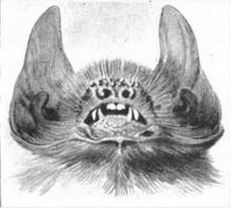Behavior
Pteronotus davyi are nocturnal, insectivorous bats that tend to roost in communities within their own species. Daytime roosts are seen to be shared between other species within the family Mormoopidae. [3] This species uses echolocation to target prey in the dark, deciduous forests they reside in. Insects preyed upon include moths, flies and earwigs. [5]
Pteronotus davyi are known to be seasonally monogamous, and usually mate in the months of January and February. [3] These bats have one offspring per mating season. The birth of the offspring occurs during the rainy season. The rainy season provides a surge in the insect population, which proves to be important for these insectivorous bats, allowing the young to mature at a fast rate. [3]
Due to their high wing-aspect ratio, these bats can fly at quick burst speeds for long distances, although their long wingspan inhibits them from having great agility. [3] [6] They are also sufficient climbers. It is believed that they climb high to the top of their roost in order to quickly fly away from the entrance and avoid any nearby predators. [3] [7] During nighttime foraging for insects, flight usually occurs near the ground. [3]
Although predation has not been intensely observed in this species, researchers have found that P. davyi has been hunted by American kestrels (Falco sparverius) a very common North American falcon. These falcons have been seen to hide at the entrance of the bat roosts and dive after the bats as they are exiting the cave. [7]
Ecology and distribution
These bats are found most commonly in moist habitats that sustain a high volume of insects. Nighttime roosts of these animals are most commonly found in warm, dark, moist caves. P. davyi are found as far north as Mexico and as far south as South America and Honduras. [3] They typically prefer low elevations, but some individuals have been observed at elevations as high as 2,000 meters above sea level. [3] There has been no recorded observance of this species in Guyana, Suriname, or French Guiana. [3] Studies of this species have revealed genetic divergence between the Southeastern P. davyi population, and the Pacific and Gulf Coast populations. [8] This is believed to be a result of geographical barriers that separate these populations. These geographical barriers are Sierra Madre Occidental, Sierra Madre Oriental, and Sierra Madre del Sur. [8]
This page is based on this
Wikipedia article Text is available under the
CC BY-SA 4.0 license; additional terms may apply.
Images, videos and audio are available under their respective licenses.


